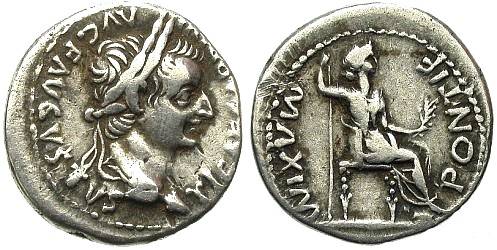
*A coin from Carthage, c.300-264 BCE, found in North India** (Ancient Coins Canada)

An imitation of a Roman coin by Tiberius (r.14-37CE), made in India and used for local trade
Source:
http://www.vcoins.com/ancient/forumancientcoins/store/viewitem.asp?idProduct=6263
(downloaded Feb. 2007)
"Tiberius, 19 August 14 - 16 March 37 A.D., Tribute Penny of Matthew 22:20-21, Ancient Eastern Imitative. Silver denarius, 2.829g, 18.2mm, 0o, TI CAESAR DIVI AVG F AVGVSTVS, laureate head right; reverse PONTIF MAXIM, Livia seated right holding scepter and branch, legs on chair ornamented, feet on footstool. Part of a hoard of nearly 200 Tiberius and Augustus denarii found in India. Imitations, such as this coin, were produced in India, and used for local trade. This coin appears to be all silver but may be plated."
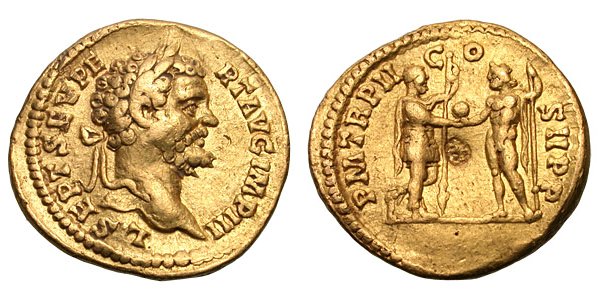
A Roman coin found in India, dated 194 CE; it has an Indian countermark
Source:
http://www.vcoins.com/ancient/harlanjberk/store/viewItem.asp?idProduct=10837&large=1
(downloaded Nov. 2006)
"Septimius Severus, Aureusm 193-211 AD, Aureus, Rome, 194 AD, 7.23g. Obv: L SEPT SEV PE - RT AVG IMP III Head laureate r. Rx: P M TR P II COS II P P Septimius, in military dress, reversed spear in l. hand, and Jupiter, nude except for cloak hanging from l. shoulder, scepter in l. hand, standing face to face and supporting globe between them with their r. hands. Very rare, possibly only the fifth known specimen, and from the same dies as the other four (BM-67, Paris, Glasgow-11 pl. 5, and Bourgey, 16 Dec. 1913, Ramon Part II, 373). This coin was found in India and has an Indian countermark on the reverse between Septimius and Jupiter."

A Roman coin dated 201 CE, found in India
Source:
http://www.vcoins.com/ancient/harlanjberk/store/viewItem.asp?idProduct=10442&large=1
(downloaded Oct. 2006)
"Septimius Severus, Aureus, 193-211 AD: Aureus, Rome, 201 AD, 6.90g. Obv: SEVERVS AVG PART MAX Head laureate r. Rx: FVNDATOR PACIS Severus togate standing l. holding branch and roll. Found in India."

An "imitative coin" copying a Roman coin, probably made in India, probably in the early 200's CE
Source:
http://www.vcoins.com/ancient/calgarycoin/store/viewItem.asp?idProduct=2667&large=1
(downloaded Oct. 2006)
"Indian Imitative Aureus muling a Hadrian obverse and a Lucius Verus reverse. Denomination : Gold Aureus. Mint : probably somewhere in India. Date: Probably minted during the Several period in the early 3rd century AD. Size: 19.5 x 20.0 mm. Weight: 6.90 grams. Obverse: Head of Hadrian right, with NSDNIANVS AVG COS III P P around. The NSDNIANVS is a barbarous form of HADRIANVS. Reverse : Lucius Verus and Marcus Aurelius shaking hands, with CONCORDIAE AVGVSTOR TRP COS II around.
The obverse could be copied from any number of Hadrian aureri issued
up to AD 137, but the reverse is copied specifically from a Lucius
Verus
aureus of type Sear #5329, issued in Rome in AD 161. There is no way to
know exactly when this specimen was struck, but sometime around the
Severan
period is most likely. It is reported to have been found in
India,
and has the typical look of an Indian imitative aureus with the very
thickened
letters and slightly course engraving. Muling of obverse and
reverse
types is not uncommon on such Indian imitative coins."

A gold "imitative coin" based on the coins of the Axumite kingdom in northeastern Africa, c.400 CE
Source:
http://www.vcoins.com/ancient/denofantiquity/store/viewitem.asp?idProduct=394
(downloaded Jan. 2008)
"Axumite. Christian Kings of Aksum. Au solidus. 400 AD. Blundered legend. Local Indian imitation. Double piercing."

Local Indian copies of Roman coins were often provided with holes, presumably so they could be worn as pendants, c.500's
Source:
http://www.vcoins.com/ancient/civitas/store/viewItem.asp?idProduct=8512&large=1
(downloaded Oct. 2006)
"Uncertain culture, imitating Rome Imitating Theodosius 455-457 AD, or later Solidus Good VF. AV Solidus 4.05g. 21mm. Uncertain Mint in India. Helmeted, armored bust facing, holding shield and spear. D V SETOI ]QVTVVG / Winged Victory standing left, supporting bejewelled cross; star in right field; CB_ in exergue. PVCTVI- IASVCCCV. Cf. RIC X 505-510.; Turner (Roman Coins Found in India). Extremely rare. Characteristic dual hole at top of obverse.
Imitations of Roman coins, particularly gold, begin in India around the Severan period. Most types predate Constantine, and 5th Century or later types are quite rare. Turner cites most coins with the dual hole as being imitations- almost unfailingly. Found in India. A fairly accurate rendering, but with incomprehensible legends. The dual hole on ancient coins is almost a secure sign of Indian use/circulation."
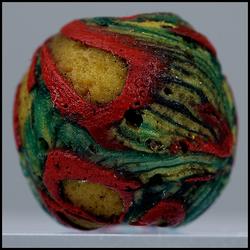 |
 |
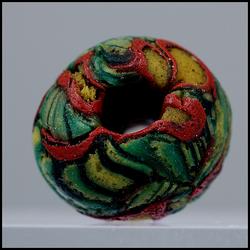 |
 |
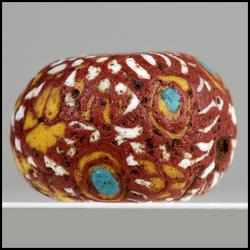 |
 |
Thousands of elaborate glass beads like these late Roman or early Islamic ones, c.3rd-7th c., have been found in Afghanistan; they were convenient items for trade or barter
Source: ebay, Aug. 2007
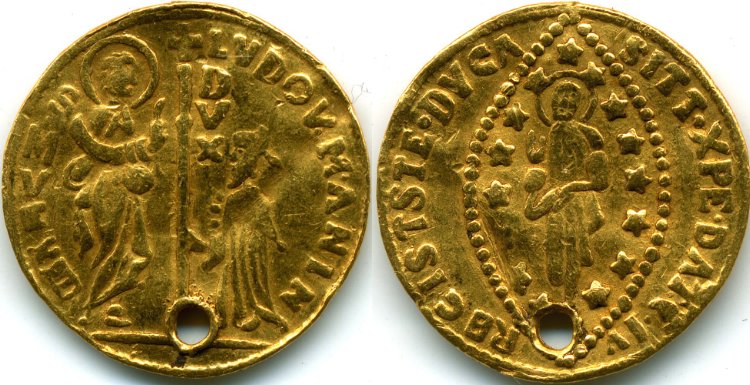
An imitation of a Venetian coin from the early 1500's, probably made in India
Source:
http://www.vcoins.com/ancient/holyland/store/viewitem.asp?idProduct=1214
(downloaded Dec. 2007)
"Venice. Andrea Gritti, 1523-1539 AD. Gold Ducato, with the Christ. imitation (India?), 3.15gm, 21mm, obv: doge kneeling before standing figure of St. Mark; rev: Christ standing within stars."
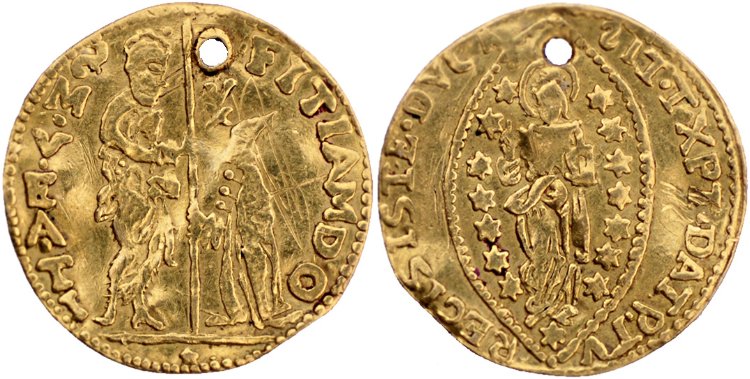
Another imitation of a Venetian coin, made in India, c.1675-1850
Source:
http://www.vcoins.com/ancient/nbnumismatics/store/viewitem.asp?idProduct=1190
(downloaded Dec. 2007)
"Venice, Andrea Gritti (1523-1539). Gold ducat- 2.8 gram. Obv: doge kneeling before standing figure of St.Mark. Rev: Christ standing within stars. Indian imitation, struck ca 1675-1850. Pierced."
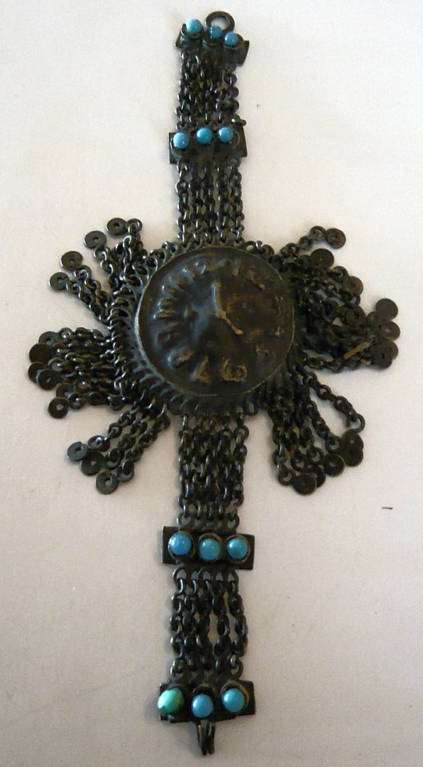
== Indian Routes index == Indian Routes sitemap == Glossary == FWP's main page ==